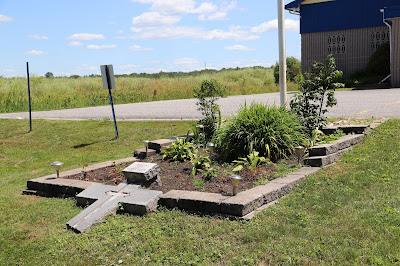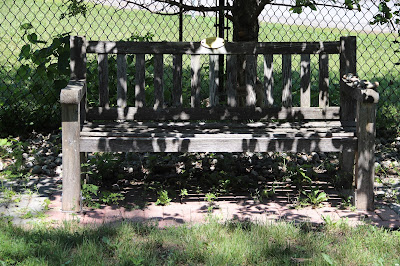The Manotick Dam is actually a series of waste water weirs that have a duel purpose. they allow the Rideau River to flow freely during the spring thaw so that the overflow dams and locks in the canal system remain undamaged. During the operating season of the Canal with the weirs closed they provide consistent high water on the upstream side of the locks. Additionally, though not built for the purpose, the dam provides power to Watson's Mill, which was built a year after the completion of the dam.
The Manotick Dam controls the flow of the Rideau River on the west side of Long Island south of Bridge Street.
Manotick Dam
Barrage de Manotick

A Safety Valve and Power Source
The Rideau Canal is a 202 kilomtre waterway made navigable by a system of ore than 50 dams, 47 locks and 19 kilometres of actual canal cuts. Built between 1826 and 1832 as British military defence strategy, the Canal served as a secure water route from the Ottawa River to Lake Ontario at Kingston. The story of its construction, operation, maintenance and use are part of our Canadian Heritage.
Spring flooding caused annual damage to the engineering works at Long Island Lockstation, located 2 kilometres downstream. A new dam was constructed at this location, made of rock-filled timber cribs and wooden stoplog weirs. It was added to the canal system in 1858, operating as a safety valve, controlling the volume and flow of water.
In 1859, local businessmen, Moss Kent Dickinson and Joseph Merrill Currier, obtained the rights to use this water to generate power for their mills built around the dam. Their enterprise prompted the development of the village of Manotick and the demise of the original village near the Long Island Locks. Since that time, the dam's role as a safety valve and power source to the Grist Mill remains essential. It has been reconstructed six times with the last two re-constructions made of reinforced concrete, in 1932 and 1980.
Today, the mechanics of dam operation is virtually unchanged. Timber stoplogs are still raised and lowered by the hand-operated winches mounted on dollies and moved from weir to weir along the track. The Canal is now a National Historic Site and has been designated Canada's 14th UNESCO World Heritage Site.

Une soupape de sûeté et une source d'énergie
Long de 202 kilomètres, le canal Rideau est rendu navigable grâce à plus de 50 barrages, 47 écluses et 19 kilomètres de canaux artificiels. Construit de 1826 à 1832 dans le cadre de la stratégie de défense militaire britannique, le canal était une voie navigable sécuritaire reliant la rivière des Outaouais au lac Ontario et à la ville de Kingston. L'histoire de sa construction, de son exploitation, de son entretien et de son utilisation fait partie du patrimoine canadien.
Les inondations printanières causaiene chaque année des dommages aux ouvrages du génie du poste d'éclusage de Long Island, situé à deux kilomètres en aval. Le barrage à cet endroit était fait de caissons de bois remplis de pierres et de poutrelles de bois. Ajouté au réseau du canal en 1858, il servait de soupape de sûreté, car il contrôlait le volume et le débit d'eau.
En 1859, des hommes d'affaiares locaux, Moss Kent Dickinson et Joseph Merrill Currier, ont obetnu le droit d'utiliser l'excès d'eau afin de produire de l'électricité pour leurs moulins bâtis à proximité du barrage. Leur enterprise a entraîné l'eeor du village de Manotick au détriment du village initial situé près des écluses de Long Island. Depuis, le barrage joue un rôle essentiel comme soupape de sûreté et source d'électricité pour le moulin. Il a été reconstruit six fois, les deux dernières fos en béton armé, soit en 1932 et en 1980.
De nos jours, les méthodes d'explotation du barrage demeurent pratiquement inchangées. Les poutrelles de bois sont toujours soulevées et abaissés au moyen de treuils manuels montés sur des chariots que l'on déplace d'un déversoir à l'autre le long du rail. Le canal est maintenant un lieu historique national et a été le 14e site canadien inscrit au patrimoine mondial par l'UNESCO.


















The Perpetual Challenge
Since the Rideau Canal opened in 1832, water management has been essential to its successful operation. Initially, water concerns focused on maintaining navigation and protecting engineering structures, with the excess water supplied to power mills.
For more than 150 years of canal operation, lumbering, settlement, commercial transport, industry, agriculture, recreation, hydro-electric power generation, tourism and urbanization have had their own effect on water management practices. Today, water management has evolved into a complex science: balancing the needs to ensure water levels, regulate water flow, maintain water quality and protect fish and wildlife.
A team of more than 10 organizations collaborate in the annual cycle of activities. Procedures are dictated by the weather and guided by historic records, a computer simulation model and years of experience. The mechanics include more than 50 dams and weirs, 13 electronic monitoring stations, water level recording at 24 lockstations, snow surveys, water sampling and thousands of hours of surveillance, adjustments and maintenance.
As an UNESCO World Heritage site, the perpetual challenge of water management and protection extends beyond the Rideau Canal. It is a challenge of shared responsibility to individuals from around the world to value and preserve our natural environment for the future generations.

Le defi perpétuel
Depuis l'ouvertre du cnal Rideau en 1832, la gestion de l'eau est un élément essentiel de son bon fontionnement. À l'origine, on se souciait avant tout d'assurer la navigation et de protéger les structures du génie; l'excès d'eau servait à alimenter les moulins.
Les pratiqus de gestion d'leau utilisées depuis la mise en fonction du canal il y a plus d'un siècle et demi ont été influencées par l'exploitation forestière, le peuplement de la région, le transport commercial, l'industrie, l'agriculture, les loisirs, la production d'hydroélectricité le tourisme et l'urbanization. De nos jours, la gestion de l'eau est devenue une science complexe : ell consiste à trouver un équilibre entre les divers besoins afin de maintenir un niveau d'eau suffisant, à régulariser le débit, à préservier la qualité de l'eau ainsi qu'à protéger les poissons et la faune.
Plus de dix organisations participent ou cycle annuel des activités. Les procédures suivies dépendent de la météo et s'appuient sur les données historiques, un modèle de simulation informatisé et de nombreuses années d'expérience. Les activités touchent plus de 50 barrages et déversoirs de même que 13 stations de surveillance électronique. Elles comprennent la consignation du niveau d'eau dans 24 postes d'éclusage, l'évaluation de l'enneigement, le prélèvement d'échantillons d'eau ainsi que des milliers d'heures de surveillance, d'ajustement et d'entretien.
Le canal Rideau, désigné site du patrimoine mondial par l'UNESCO, n'est pas le seul endroit où la protection et la gestion d'leau posent un défi perpétuel. Des personnes du monde entier doivent relever le défi de valoriser et de préserver notre milieu naturel pour les générations à venir.





















































































